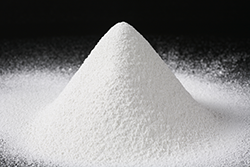Compounds
When mentioning zinc, most tend to think of zinc metal. However zinc chemicals (including zinc dust) account for about 10% of total zinc consumption and play a host of critical roles in modern society.
Zinc powders and dusts are essentially finely divided zinc metal. A distinction is often made whereby ‘zinc dust’ refers to the product made by condensation of zinc vapor and ‘zinc powder’ to the product of atomization of molten zinc. However, since the difference between powder and dust is essentially a matter of fineness, dusts being finer – sometimes the terms ‘dust’ and ‘powder’ are used simply to differentiate fine or course materials.
Zinc dust and powders are widely used in the chemical industry to purify solutions by cementation or to achieve other reductions. Specific applications for special grades of zinc powders include alkaline batteries, paints, grease  and lubricants, brake linings, plastics, pharmaceuticals and the recovery of noble metals, among others.
and lubricants, brake linings, plastics, pharmaceuticals and the recovery of noble metals, among others.
Fireworks often make use of zinc dust to create bright, shimmering sparks. The zinc metal flakes heat up until they are incandescent and shine brightly or, at a high enough temperature, actually burn. A variety of chemicals can be added to create the brilliant colors, but it is the zinc that sparkles.
 Zinc Oxide
Zinc Oxide
Zinc oxide (ZnO) is the most widely used zinc compound and can be produced according to a number of different processes. In the French (indirect) method, zinc oxide is produced by the combustion of zinc metal. When zinc oxide is extracted from zinc ore or smelter by products (e.g., using oxidized zinc) it is called the American or the direct method. There are also wet chemical processes that begin with purified zinc solutions, although the French method remains the most common.
One of the main uses of ZnO is as a vulcanizing activator in the rubber industry. It is especially critical in the manufacturing of tires where it imparts unique characteristics such as increased resilience and elasticity – literally putting the ‘bounce’ in rubber.
Ceramics is another major market for ZnO where it is used for the production of frits, artistic glasses and enamels. The beauty and durability of todays ceramic tiles, cookware and tableware are made possible by zinc oxide.
ZnO is also used in paints as a pigment and improves the lightfastness and hardness of the coating. It also imparts corrosion protection properties to the paint, acts as an anti-fouling agent and also has good anti-microbial properties.
Sunscreens rely on ZnO for its UV absorbing properties and baby creams and wound-care ointments contain zinc oxide for its regenerative effect on the skin.
 Other Zinc Chemicals
Other Zinc Chemicals
Have you ever wondered how things glow in the dark? All glow-in-the-dark products contain phosphors. A phosphor is a substance that radiates visible light after being energized. To make a glow-in-the-dark object, you want a phosphor that is energized by normal light and that has a very long persistence. Zinc sulfide has these properties and is used to create everythi ng from luminescent watch dials to glow-in-the-dark toys. Zinc’s phosphorescent properties have also made it a key ingredient in X-ray and TV screens, fluorescent lights and light emitting diodes.
ng from luminescent watch dials to glow-in-the-dark toys. Zinc’s phosphorescent properties have also made it a key ingredient in X-ray and TV screens, fluorescent lights and light emitting diodes.
All living things require zinc for growth and survival and yet many regions in the world are plagued by zinc deficiency. To remedy this, zinc sulfate is often added as a trace element to fertilizers to promote healthy and high-yield growth and also to animal feed. Zinc sulfate, along with ZnO and other forms of chelated zinc are also commonly found in dietary supplements and other medical treatments.

